Variety "Giant Lemon" - a tomato with an extraordinary taste, bright color and incredibly large juicy fruits
Yellow tomatoes are just as popular as red and pink ones. They are consumed fresh, canned for the winter and processed into ketchups of an unusual color. Therefore, most gardeners grow sunny-toned tomatoes on their plots.
There are a large number of varieties and hybrids of yellow tomatoes. Among them, farmers try to choose those that have a pleasant taste and immunity to diseases. Among them, the lemon giant tomato stands out with fruits corresponding to the name of the size.
The content of the article
General description of the variety
The lemon giant is a variety bred by domestic breeders. Thanks to its original color, gigantic fruit size and pleasant taste, the Gigant has won the love of Russian and foreign gardeners.
It was included in the State Register in 2000. The seeds of this variety are produced by Russian and Ukrainian companies.
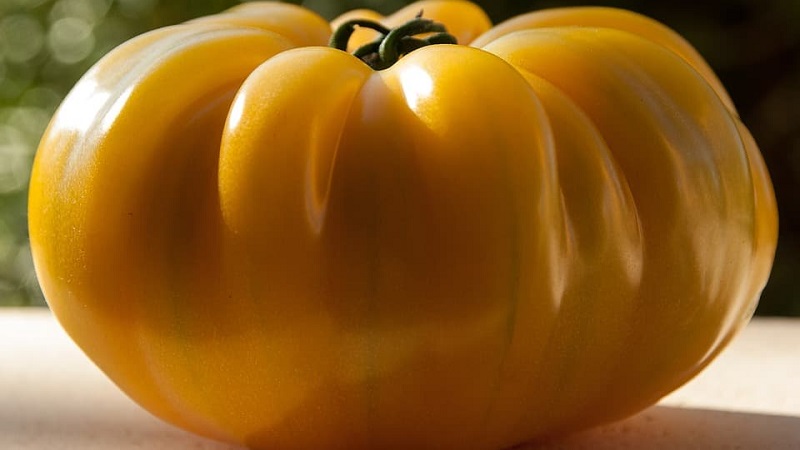
Features of the Lemon Giant
The main distinguishing feature of the Giant is the bright yellow color of the fruit. This is the shade of a tomato both inside and out. See how tomatoes of this variety look in the photo.
This is a truly gigantic variety. Its fruits are very large, some specimens reach a weight of 800 g.
Fleshy tomatoes. The composition contains an increased content of vitamin C and beta-keratin. Tomato Lemon Giant is recommended to be included in the diet for vitamin deficiency.
The variety is universal. Yellow tomatoes have a sweet, slightly sour taste. They are good in salads and preserves. Gardeners claim that their taste does not change even when frozen.
Plant bushes indeterminate... They can reach a height of 3 m. They need a garter and pinning.
The variety is immune to the main viral and fungal diseases, but sometimes it still gets sick.
Important. A distinctive feature of Lemon Giant tomatoes is their whimsical nature of the soil. Therefore, when growing it, it is important to follow the fertilizing schedule.
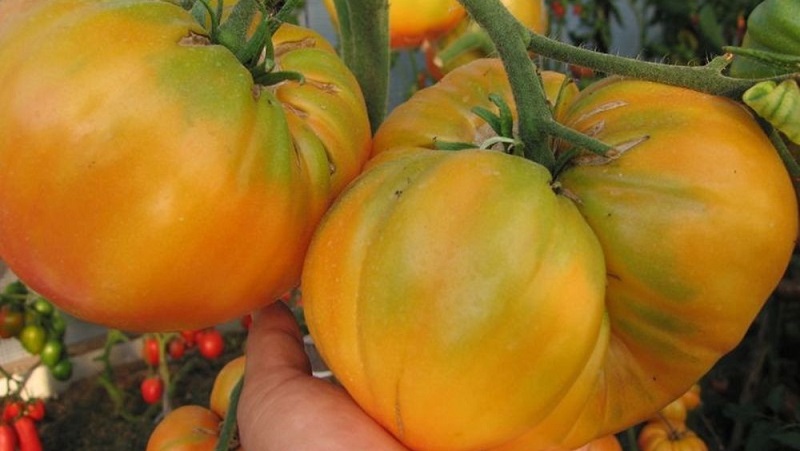
Specifications
The variety is striking in its performance. They will impress even experienced gardeners.
Characteristics and description of the variety:
| Parameter | Indicators |
| Bush type | Indeterminate. Grows in to a height of 2-3 m. The steles are powerful, with an average amount of foliage. Tomatoes are formed by tassels, each of which forms up to 6 pieces. Up to 5 brushes grow on one stem. The inflorescences are simple. |
| Growing method | Grown in greenhouses and open ground. Unprotected soil is used only in the southern regions. |
| Yield | High. Up to 6 kg of fruit can be harvested from one bush. |
| Fruit | Large. The weight of one fruit is 500-800 g. The glossy skin has a bright yellow color. Inside, the fruits are also yellow, lighter towards the middle. The fruits are fleshy, but juicy. Inside are many small chambers, with few seeds. The taste is sweet with an indistinct sourness. The shape is round, flattened and ribbed at the base, and slightly elongated at the tip. |
| Transportability | High. Tomatoes have strong skin, whole fruits are stored for a week. |
| Ripening terms | Mid-season variety. The first ripe fruits appear 105 days after the first shoots appear. |
| Disease resistance | Resistant to the main viral and fungal diseases of tomatoes. |
Growing seedlings
Tomatoes are planted in open ground when the soil warms up enough. This happens at different times in different regions. The timing of sowing seeds for seedlings depends on this.
Seeds are sown two months before being transplanted into open ground. In most regions, the end of February-March is considered the optimal time.
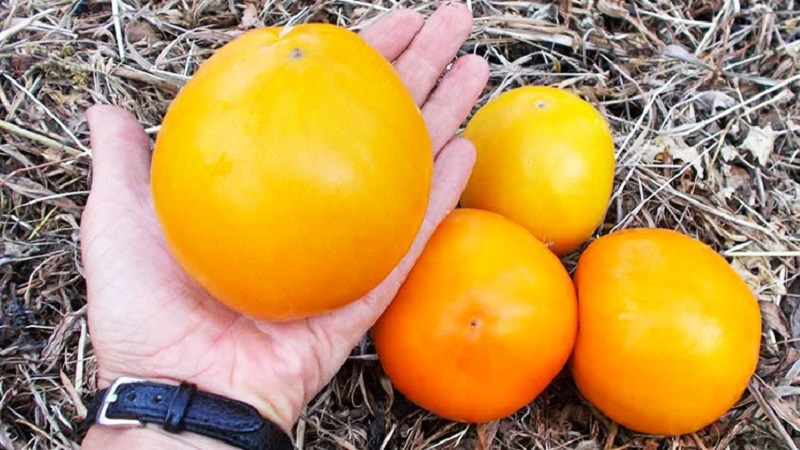
Seed preparation
Before you start sowing seeds, you need to prepare them. This will prevent infestation of the plants and increase and speed up their germination.
Preparation of planting material:
- Before sowing, you need to select material that is capable of sprouting. To do this, it is sorted out, removing all damaged and blackened seeds. An easier method is to soak the planting material in salted water for half an hour, removing all floating seeds.
- Treatment of planting material with disinfecting compounds will prevent plant diseases. To do this, the seeds are soaked for two hours in hydrogen peroxide. Potassium permanganate is also used for these purposes.
- Tomatoes are soaked in a growth promoter for 12 hours. These can be purchased products or home remedies such as aloe juice.
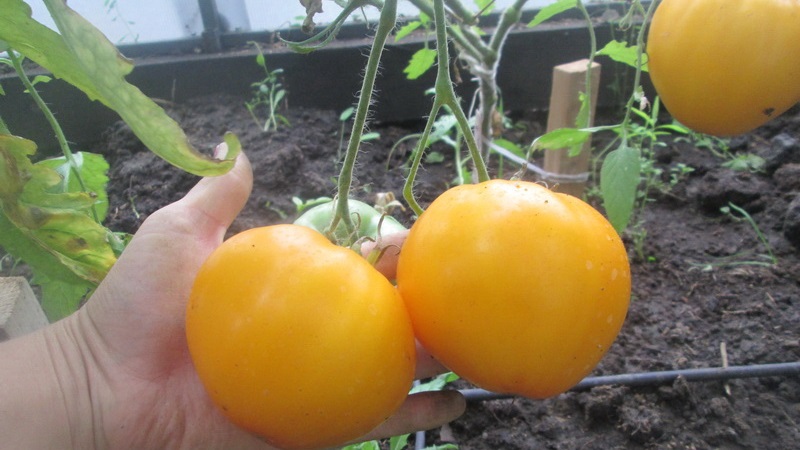
Soil and containers
In most cases, seeds are sown in one large container. For example, special trays and boxes or homemade pots. Such a container does not have to be deep.
If you plan to grow only a few bushes of this variety, then you can sow seeds directly into individual containers. It is convenient to use peat pots and tablets.
Individual containers are used for picking grown plants. Their volume must be at least 300 g.
Preparing potting mix is not difficult. There are many variations of these formulations. Peat, turf and humus taken in equal proportions are the simplest and easiest soil to prepare.
Store formulas are also suitable for growing tomato seedlings. Light soils are suitable for this crop.
Before using the soil and seedling containers, you need to decontaminate them. The earth is calcined in the oven, poured with boiling water or a solution of potassium permanganate. Containers for planting seeds are wiped with a solution of potassium permanganate, hydrogen peroxide, alcohol, or sterilized using high temperatures.
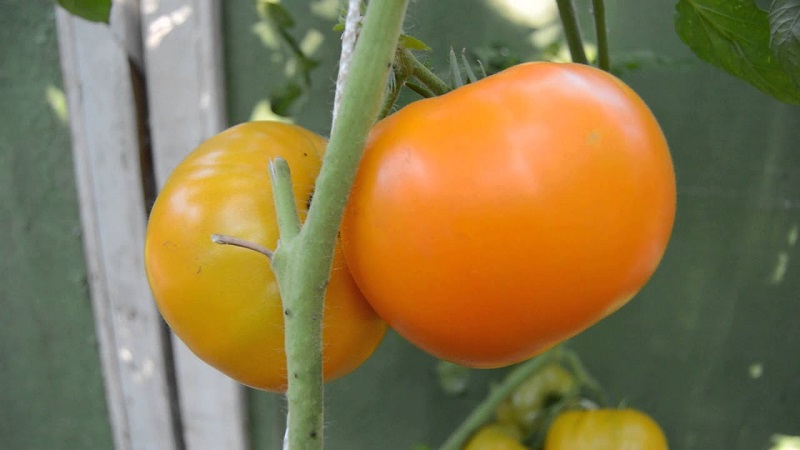
Sowing planting material
After carrying out preparatory work, proceed directly to sowing. For this, grooves with a depth of 2 cm are made in the soil in rows, located at a distance of 3 cm from each other. Seeds are poured into them at a distance of 2 cm from each other. From above, the seeds are covered with soil.
The soil is moistened with warm water from a spray bottle, cover with foil and place in a warm place. Before the first shoots appear, it does not have to be well lit.
There are other options for sowing seeds. Below is the most unusual of their ways.
Growing seedlings without land:
- Take a plastic food tray. If not, then you can cut the bottle lengthwise into two parts. One of the halves is used for growing seedlings.
- Several layers of toilet paper or napkins are lined at the bottom of the plastic container. It is thoroughly moistened with a spray bottle.
- Seeds are spread on paper at a distance of 2 cm from each other. On top they are covered with several layers of toilet paper.
- The paper covering the seeds is moistened with a spray bottle.
- From above, the container with seeds is covered with a film in which there are holes. As the paper dries, moisten it with warm water.
When using this method, the plants dive in a container with the ground as soon as they have cotyledon leaves. Otherwise, they will turn yellow and die due to lack of nutrients.

Seedling care
Proper care of the seedlings will allow you to grow healthy and viable plants that can easily be transplanted to a permanent place.
How to care for seedlings:
- Seedlings dive into individual containers after the appearance of 2-3 true leaves. Plants are carefully removed from the ground and placed in a new location. It is not necessary to pinch the central root; a sufficient number of small roots are damaged during transplantation.
- Water the seedlings as the soil dries. For these purposes, use settled water at room temperature. When watering, it is important that the water hits the ground, but does not touch the greenery of the plants.
- Top dressing is done at least three times during the entire time of growing seedlings. For this, complex fertilizers are used. They are poured over the soil in which the tomatoes grow. The first time feeding is applied 10 days after the picking of the plants, and the last one 3 days before they are transplanted into open ground. The second feeding is done between them.
- In order for the plants to take root well after transplanting into the ground, they need to be hardened. To do this, two weeks before they are disembarked at a permanent place, the seedlings are taken out into the fresh air, gradually increasing the time they spend outside.
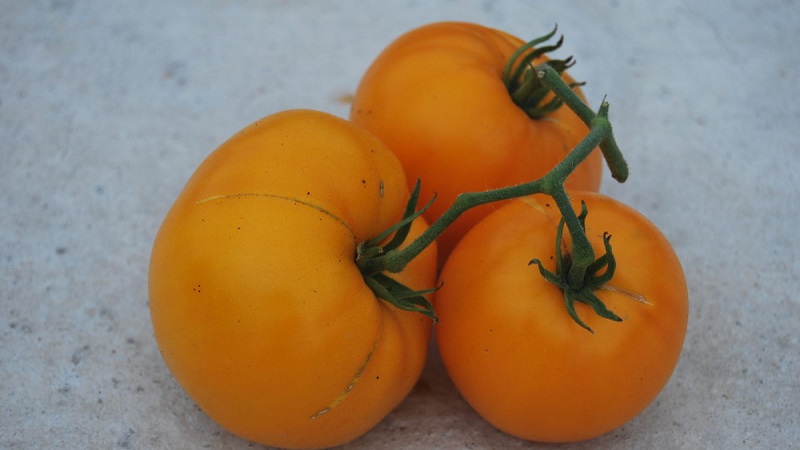
Growing tomatoes
When the soil warms up enough, the seedlings are planted in a permanent place. This is usually done in the second half of March. In the middle lane, many gardeners plant tomatoes in the ground in early June.
Landing at a permanent place
Three days before planting, the plant is abundantly watered and fed. After transplanting, the soil cannot be moistened for two weeks.
In the fall, you need to prepare the beds. For this, the soil is dug up, cleaned of plant residues. Ash and humus are added to the soil.
In the spring, the soil is dug up again. It is disinfected by pouring a solution of potassium permanganate or copper sulfate.
Then dig holes. A distance of 60-70 cm is maintained between rows, 50-60 between holes. To save space, the seats are staggered.
Immediately before planting, the seedlings are carefully removed from the pots along with a lump of earth. They are placed in the holes, forming the roots towards the center.
Wells with plants are filled with water at room temperature. After that, they are covered with soil.
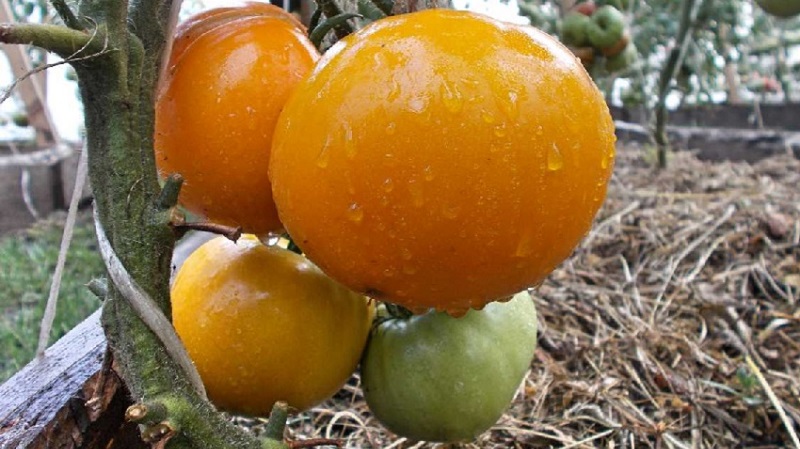
Plant care
Lemon Giant tomatoes need a garter. Otherwise, heavy fruits will break the stems. Bushes are tied to wooden supports or trellises.
The bush is formed into one or two stems. In the first case, the fruits will ripen faster, and in the second there will be more of them.
You regularly need to break off the extra stepsons and withered leaves. This should be done in the evening or morning.
Plants are watered infrequently, but abundantly. The best time to moisturize the soil is morning or evening.
Attention! The Giant Lemon variety is picky about the composition of the soil. Therefore, you need to feed such tomatoes at least 4 times a week. The first time the plants are fertilized two weeks after transplanting it into the ground. Subsequent feeding is done every two weeks.
Root complex mineral and organic fertilizing is used. As complex fertilizers used such means as "Kemira Lux", "Solution", "Red giant". Mullein, biohumus are used as organic matter.
Foliar dressing will speed up the formation of ovaries. Use boron formulations.
What difficulties can you face
When growing Lemon Giant tomatoes, a novice gardener may face a number of difficulties. The list contains the main ones:
- Tomatoes are getting fat. A large amount of greenery is formed on the plant, which is why the fruits become smaller and more slowly ripen. This suggests that the soil is oversaturated dressing... You need to reduce the amount of fertilizer.
- Few ovaries are formed. This indicates the poverty of the soil. It is necessary to increase the amount of dressings.
- Giant fruits do not grow. You can increase the weight of tomatoes by reducing the number of flowers on the plant.
- The fruit is watery and cracked. This indicates that the grower removed too much of the foliage and all the water was transferred to the tomatoes.
Pests and diseases
Giant lemon tomatoes are resistant to the most common fungal and viral diseases of this culture. Without preventive treatment, the risk of infection remains.
To prevent tomato infestation, their seeds and the soil in which they are planted are treated with disinfecting solutions. Prevention includes the selection of soil on which nightshade crops were not grown last year.
Disinfection of the soil helps not only to avoid infection of plants with viruses and fungi, but also to destroy the larvae of pests. In addition to potassium permanganate and copper sulfate, a remedy such as Fitosporin is used.
To protect plants from insects, they are sprayed with insecticides before the first inflorescences appear. Then natural formulations are used, for example, a soap solution.
Differences between growing in a greenhouse and in an open field
The Giant Lemons variety is grown in a greenhouse and in the open field. There are no particular differences in the care of these plants in both cases.
When cultivating a plant in a greenhouse, it is important not to forget to ventilate the room. To do this, open windows in the structure.
In the open field, the first two weeks after transplanting tomatoes, they are covered with foil. In the warm season, it is removed.
Mulching essential for tomatoes growing outdoors. As mulch use burlap, hay, straw and even film.
Harvesting and application of the crop
The ripeness of tomatoes is indicated by the bright yellow color of their shell. The first ripe fruits are harvested at the end of July.
Ripe tomatoes are torn off together with the stalk. This will increase their shelf life.
In cloudy weather, it is better to pick unripe large fruits. This will reduce the chance of plant infection late blight... Green tomatoes will ripen at home.
The lemon giant is a versatile variety. It is eaten raw, used for cooking hot meals and preservation.
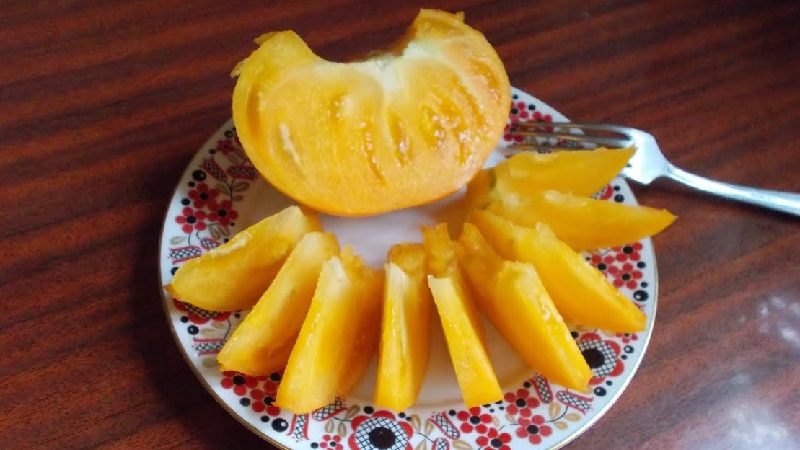
Benefits of the Lemon Giant
Benefits of Giant Lemon:
- bright fruit color;
- great taste;
- immunity to tomato diseases;
- the possibility of growing indoors and outdoors;
- the possibility of growing seeds from fruits;
- large-fruited.
The disadvantages of the Lemon Giant include the need for garter and pinching, as well as exactingness to the composition of the soil.
Variety reviews
Gardeners speak well of the lemon giant tomato. Anyone who has tried it once wants to grow it again.
Irina Perepelkina, Sochi: “I have been planting Giant Lemon for several years now. I grow in the open field. It rarely gets sick and produces delicious giant yellow tomatoes. I use it to cook tomatoes and roll several jars of unusual yellow ketchup every year for the holidays. "
Anna Kotova, Belgorod: “This year I planted the Lemon Giant. Before that I tried it with a friend, and did not doubt the taste. Very tasty, beautiful and large-fruited variety. Individual fruits weighed slightly less than a kilogram. The only drawback is that you do not need to skip feeding. I will still plant "
Conclusion
Tomato Giant Lemon is a variety with bright yellow fruits. They are gigantic in size. When grown correctly, they reach 800 g.
Even a novice gardener can handle the cultivation of such tomatoes. In order not to be disappointed in this variety of tomatoes, you need to timely fertilize and water the plants.